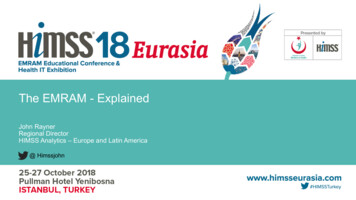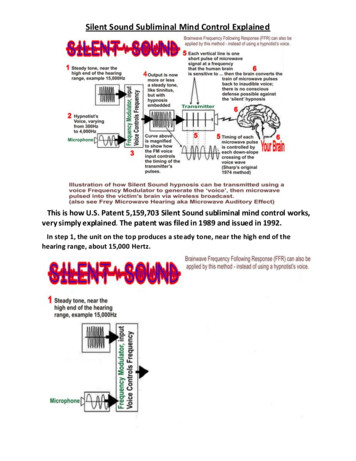
Transcription
The EMRAM - ExplainedJohn RaynerRegional DirectorHIMSS Analytics – Europe and Latin America@ Himssjohn
Healthcare Information and Management Systems Society (HIMSS)HIMSS is a global, cause-based, not-for-profit organization focused on better health through information andtechnology (IT). HIMSS leads efforts to optimize health engagements and care outcomes using information technology.HIMSS AnnualConference, CorpMembership,Regional Events,etc.LOGIC , AdvisoryServices, MaturityModels, Insight &Research, ThoughtleadershipMarketing Arm,Healthcare IT News,Local Forums, ContentCreation & Syndication,etc.
Healthcare’s Most Comprehensive MarketIntelligence Resources & Advisory SolutionsHealth ITMarket IntelligenceConsultancy andAdvisory ServicesHealthcareOrganisationalBenchmarking
HealthcareDeliveryOrganisationsUniquely Positioned toDeliver Actionable IntelligenceHealth ITSolutionProviders
Plan for the session . Background information The patient safety story - Why we measureadoption The EMRAM standards – The requirement ofeach stage Questions
Enabling better health throughinformationtechnology.
250,000 US Citizens die each year asa result of Medical Error .
250,000 US Citizens die each year asa result of Medical Error .9.5% of the totalnumber of annualdeaths8000 of those aredrug errors60,000 die eachyear withoutappropriate healthcare.Many of thesedeaths arepreventable.
The NHS in the UK causes 40,000deaths a year .
The NHS in the UK causes 40,000deaths a year .7% of the totalnumber of annualdeaths900 of those aredrug errorsMany of thesedeaths arepreventable
Elsewhere?
PJ Salaman FRCS . “I need technology to make iteasy for me to do the right thing– and difficult for me to do thewrong thing”
How easy?
An easy mistake to make!!
And easy to do the right thing .Cyclobenzaprineis a musclerelaxant used totreat spasm andskeletal painCyproheptadine is anantihistamineused to treatallergicreactions
Making the news
Closed Loop Medication AdministrationA Key Element of Patient Safety 0%Manual2,0%0,0%Timing relatederrorsNon-timing relatederrorsErrors with ADEpotentialTranscriptionerrors in medadmindocumentationSource: Effect of Bar-Code Technology on the Safety of M edication Adm inistration;Poon, Keohane, Bates, Lipsitz, et al, New England Journal of M edicine, 2010;362:1698-707, M ay 6, 2010
Blood Administration. Mis-transfusion errors accounted fornearly 40% of the ABO-incompatibletransfusions reported by Linden et al(2000) who estimated that 1 in 14 000transfusions involved ABO errors 8 A Hong Kong health system reported100% reduction in administration errorsof 27,000 units administered9 100% accuracy of patient identificationobtained for blood samples and bloodproducts administration with bar codeenablement108 British Journal of Haem atology Volum e 136, Issue 2, pages 181–190, January 20079 Hong Kong M ed J Vol 10 No 3 June 2004, pgs 166- 17110 TRANSFUSION 2003;43:1200-1209
Paperless by 2018 /2020/ 2022
Case study Patient admitted over theweekend. Case notes were notimmediately available Patient was slightly confusedand a poor historian Given 6 drugs in the first 24hours Allergic to 4 of them Patient died
Could it happen again?
Focus on the acute EMRAM.
EMR Adoption Model (EMRAM) 2005Stage 7Complete EMR; CCD transactions to share data; Datawarehousing; Data continuity with ED, ambulatory, OPStage 6Physician documentation (structured templates), fullCDSS (variance & compliance), full R-PACSStage 5Closed loop medication administrationStage 4CPOE, Clinical Decision Support (clinical protocols)Stage 3Nursing/clinical documentation (flow sheets), CDSS(error checking), PACS available outside RadiologyStage 2CDR, Controlled Medical Vocabulary,CDS, may have Document Imaging; HIE capableStage 1Ancillaries – Lab, Rad, Pharmacy – All InstalledStage 0All Three Ancillaries Not Installed
Times have changed It was time for more significant changes Needed to better reflect current state of an advanced EMR environment All stages were affected Time to raise the bar globally Focus more on functions accomplished and less on technology itself How is technology used to improve care quality and patient safety?
EMR Adoption Model (EMRAM) Designed initial “strawman” in July 2015 – several iterations Continued to refine as we progressed towards implementation Focused discussions with international stakeholders individually andin groups Global listening sessions Stage 6 & 7 and Davies organizations HIMSS Executive Institute Suppliers of local & international EMR systems and vendors in general
EMR Adoption Model (EMRAM)
The Changes .New StandardsSome elements have movedIncreased compliance
Stage 1 – Main Diagnostic Systems Results On-Line Radiology information system Laboratory information system Pharmacy management system PACS (radiology & cardiology) for DICOM 100% filmless Non-DICOM images are available via the network
Stage 2 – Core Clinical Data Store Clinical Data Repository – Single or multiple fully integrated data stores installed in such away that users DO NOT have to sign into different systems Such linkages are context aware (i.e., patient does not need to be re-selected in each disparatedata store) Data availability 95% - CDR provides access to 95% of lab results and radiology andcardiology reports Remote access – Information is accessible from outside the hospital Security: Physical access policy in place; security training programAcceptable use policy in place with training programMobile security in placeData destruction policy in placeDevice encryption in placeAnti-virus, anti-malware tools in placePrevention of PHI storage on assets owned by the organization and BYOD (if allowed)
Possible Questions . Do you have a Physical access policy in place and enforced? How often is the physical access policy reviewed and updated? Do you have an acceptable use policy in place and enforced? How often is the acceptable use policy reviewed and updated? Do you provide EMR Security training for new users? Do you provide EMR Security refresher training for existing users? How often do you provide EMR Security refresher training for existing users? What percentage of existing users have received EMR Security refresher training within 12months of their previous training?
Possible Questions . Are you encrypting data stored on data storage devices such asworkstations, laptops, and other mobile devices (e.g., hard drives,SSDs, external storage devices, etc.)? Do you have a data destruction policy in place and enforced? Do you have antivirus and antimalware programs in place on alldevices connected to your network?
Possible Questions Are all mobile devices (owned by the organization) that are in useand operating on the network registered/authorized for use? Thisincludes all Laptops, Tablets, PDAs, Mobile/Smart Phones. Can you prevent the storage of protected health information (e.g.,patient data) locally on assets owned by the organization and userowned devices (BYOD). (This includes stationary and mobileworkstations, storage devices such as CD, memory sticks etc.)
Stage 3 – Care Documentation is On-Line Clinical Documentation - Nurses and allied health professionals (not physicians) documenting inthe EMR using structured templates and capturing discrete information Vitals, nursing notes, nursing tasks, etc. eMAR is implemented Clinical Documentation 50% – Hospital choses calculation method (50% of all wards, patientdays, inpatient cases, etc.) Clinical Documentation live in ED (if ED exists) – Excluded from 50% Security: Role-based access control (RBAC)
Possible Questions Is role-based access control (RBAC) live and in use?How are vital signs being captured and documented?Is electronic clinical documentation live in the ED?Is electronic clinical documentation live in 50% of inpatient areas?Are allied health professionals documenting electronically?
Stage 4 – Physician Orders Are On-Line CPOE 50% (Use same metric previously used) with second level clinical decision supportcapabilities related to evidenced-based pathways & protocols CPOE live in the ED (if ED exists) – Excluded from 50% Clinical Documentation 90% - Nursing / Allied Health documentation increases to 90% (usesame calculation method from Stage 3) National / Regional patient database connection - Where publically available, physicians useaccess to public databases for decision making (e.g., medications, images, immunizations, labresults, etc.) Business continuity - Access to patient allergies, problem & Dx list, medications, and recent labresults when EMR is down Intrusion detection – Hospital can detect possible network intrusions
Possible Questions Are doctors using CPOE in 50% of inpatient areas? Is CPOE live in the ED? Are nurses and ALP’s using electronic clinical documentation in 90%of inpatient areas? How is business continuity maintained in the event of an outage? Does the Doctor access regional or national databases? Is an Intrusion Detection System live and in use?
Stage 5 – Physician Documentation Physician Documentation using structured templates – Capturing discrete data or derived via NLP foralerts, clinical guidance and to serve analytical capabilitiesPhysician Documentation 50% – Use same calculation method used for clinical documentation in Stage 3 Physician Documentation live in ED (if ED exists) – Excluded from 50%Order/Task Timeliness Monitoring – Hospital can track and report timeliness of nurse order completion. Recommended goal (not scored): 90% of orders are completed within two hours of scheduled time.Security: Intrusion prevention – Hospital can prevent network/EMR intrusions Portable device (hospital owned) security Devices recognized & authorized to operate on network Devices can be remotely wiped
Possible Questions Are Doctors using electronic clinical documentation in 50% of inpatient areas? Are Doctors using electronic clinical documentation in the ED? Is an Intrusion Prevention System live and in use? Is there a process to monitor and manage task completions? Are all mobile devices (owned by the organization) that are in use and operating on the network registered/authorizedfor use? This includes all Laptops, Tablets, PDAs, Mobile/Smart Phones, Storage Devices/USB Sticks, and Cameras in use. Can all registered/authorized mobile devices (owned by the organization) that are in use and operating on the networkbe remotely controlled/wiped if they are lost or stolen?
Stage 6 – Verification at POC via Technology Technology is used to Order medications and blood products ( 50%)Verify medication / blood product orders ( 50%)Verify patient ( 50%)Verify medications / blood product at the point of administration (medication, dose, route, patient, time) ( 50%)Verify human milk mother-baby match where there is communal storage of milk ( 50%)Collect and track specimens ( 50%) Technology-enabled medications / blood products / human milk administration live in ED (if ED exists) –Excluded from 50% Clinical Decision Support – Background algorithms generate at least one alert for physicians triggered byphysician documentation and/or other variables Security: Mobile device security policies applied to BYODBYOD devices must be registered/authorized for useSecurity risk assessment performed annuallyRisk assessments reported to governing authority
Possible Questions . Is there a policy in place and enforced relating to allowing the use ofdevices not owned by the organization (e.g., BYOD)? Show some examples of clinical decision support? Are all devices not owned by the organization (e.g., BYOD) that are in useand operating on the network registered/authorized for use? Can all registered/authorized devices not owned by the organization (e.g.,BYOD) that are in use and operating on the network provide restrictedaccess to patient records and be remotely controlled/wiped of all criticalpatient information if they are lost or stolen?
PossibleQuestions . Does the organization conduct periodic security risk assessmentsand report the results to the organization's appropriate governingauthority? How often does the organization conduct security risk assessments? Is technology being used at the POC across 50% of the inpatientareas?
Stage 7 – Pervasive of Use and Management Paper charts no longer used to deliver & manage care Mixture of discrete data, medical images, document images available within the EMR Data analytics leveraged to analyze patterns of clinical data to improve quality of care, patient safety, andcare delivery efficiency Clinical data can be readily shared in a standardized, electronic manner as appropriate Summary data continuity for all services is demonstrated
Stage 7 – Pervasive of Use and Management CPOE 90% - use same calculation method used in Stage 4 Physician Documentation 90% - use same calculation method from Stage 3 Privacy and security program – Present overview of strategy, infrastructure, policy andprocedures NON-SCORED: Implementation & use of Anesthesia Information System (five to seven years’ notice) CPOE-enabled infusion pumps (seven to ten years’ notice) Order/Task Timeliness 90% – All orders are completed within two (2) hours of schedule90% of the time
Picture Quiz
Picture Quiz almrNo
Picture Quiz
Picture Quiz ORIsotonicBuscopanUlcramMetpamid
Picture Quiz .
Picture Quiz .
Picture Quiz .
Picture Quiz .
Picture Quiz .
Picture Quiz .
Picture Quiz .
Picture Quiz .
Picture Quiz .
Picture Quiz .
Picture Quiz .
TCM .
Ingredients .
Patient Instructions
Voila !!
The Online Survey .EMRAM PDF
Stage 6 Validation process Stage 6 validation Hospital must submit requested data to be scored Data undergo quality review process for completeness When completed, EMRAM score is calculated and basic gap assessment report provided GapAnalysis If scored at 6, hospital must undergo an on-site validation before Stage 6 is granted Must be validated at Stage 6 to be eligible for Stage 7 Stage 6 validation On-site; focused on criteria only through Stage 6 One reviewer from HIMSS Analytics Decision is made at end of visit with written report sent within two weeks of visit
Stage 7 Validation Process Three parts Part I – Logistical prep call Part II – Video conference presentation by candidate on IT Security Disaster Recovery/Business Continuity Part III – On-site validation 2 Full days onsite visit Opening candidate presentations followed by department visits Closing session with validation decision & findings
Stage 7 Preparatory GuideStage 7 Preparatory Guide
Onsite validation (Typical agenda) Introduction and welcome Organisation overview System Overview & Pervasiveness of UseGovernanceClinical & Business IntelligenceHealth Information ExchangeDisaster Recovery & Business ContinuityPrivacy & Security Clinical observations Medical and Surgical areaICUMedical and Surgical areaERPharmacyLaboratory and Blood bankImaging departmentMedical records and clinical coding Review team discussion and final validation decision
Benefit and Value . Benefits of using an ElectronicPatient / Medical Record System Benefits being able tobenchmark and compare Benefits and value of being aStage 6/7 hospital
Value and Benefit . Benefits of using technology Reducing sepsis and sepsis related mortalityReducing Length of StayReducing the number of in patient falls and harm from fallsReducing the number and severity of adverse drug eventsReducing the number of inappropriate investigations and X ray examinations
Value and Benefit Measurement and Benchmarking Investment in technology and patient safetyInvestment in technology and improved clinical careHigher levels of patient and staff satisfactionImproved staff retention and recruitment Third party attestation The EMRAM score helps to measure and compare
Value and Benefit Being an EMRAM Stage 6/7 hospital Paying lower insurance premiums in those countries where such schemes exist(NHS Resolution formerly NHS Litigation Authority) Members of staff are less likely to move from Stage 7 hospitals to Stage 4hospitals than they are between Stage 6 hospitals thus staff retention is a factor Being more likely to withstand legal claims involving record keeping, data loss andmedical negligence Being more attractive to those who pay and commission (CCG’s and insurancecompanies) Regulators in some countries require hospitals to be at Stage 6 Being more competent, safe and outwardly sophisticated to those who regulate(CQC, JCI) Greater levels of patient satisfaction and patient confidence in those countrieswho measure these parameters (Higher NPS and Family and Friends score)
Value and Benefit Being an EMRAM Stage 6/7 Hospital Modernisation, managing successful change, innovation, clinicalengagement, strong leadership and the ability to successfully invest Attracting positive attention from others who wish to learn, emulate anduse for reference purposes Potential financial remuneration from system suppliers in return forreference site status The ability to withstand ministerial, MoH and other forms of politicalscrutiny Kudos, respect and other forms of reward and privilege. (Invited to joinnational committees, reference opportunities, speaking and presentingopportunities, councils etc) Stage 7 hospitals in some countries often have the ability to influencethinking, strategy and product development
Stage 6 / 7 Hospitals in Europe
Europe and Latin America CountryAwardeesStage 6Stage SwitzerlandTurkeyUnited Kingdom1116616533211
Ministerial Leadership All hospitals completed anEMRAM survey Many hospitals quicklyimproved The relationship continues
Good practice visits .
Thank you!John RaynerRegional Director – Europe and Latin America@ Himssjohn
HIMSS is a global, cause-based, not-for-profit organization focused on better health through information and technology (IT). HIMSS leads efforts to optimize health engagements and care outcomes using information technology. . EMR Adoption Model (EMRAM) Designed initial "strawman" in July 2015 - several iterations Continued to .










